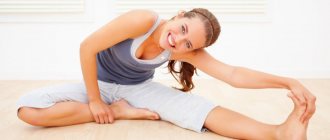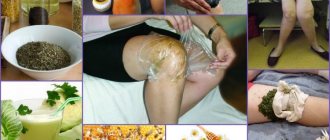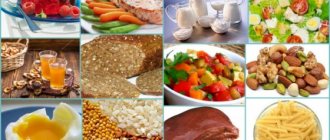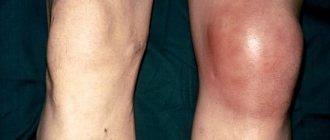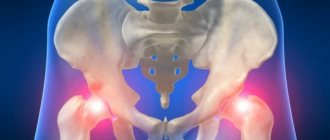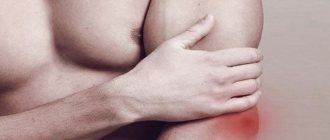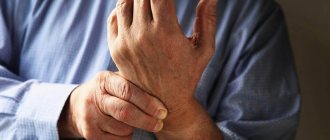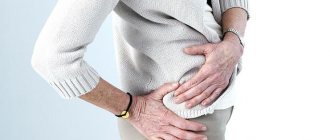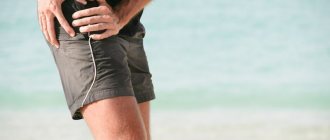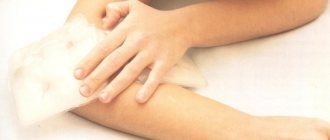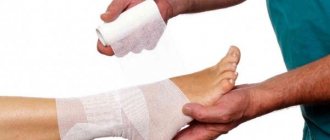The hip joint is responsible for maintaining weight, posture, and movement. In order to fully fulfill its natural purpose, the condition of a large hinge joint must be stable. This property ensures a strong muscular apparatus, a durable fibrous capsule, and deep penetration of the head into the articular cavity. The listed factors are not relevant when arthrosis of the hip joint occurs. Symptoms and treatment with folk remedies are still the subject of controversy among orthopedists. An appointment with a doctor is required.
Signs of illness
Signs of coxarthrosis resemble the manifestation of several other pathologies of the musculoskeletal system, and therefore require differential diagnosis.
The following symptoms indicate the development of arthrosis of the hip joint:
- Pain in the groin area. In 9 out of 10 cases, the pain moves down the leg, affecting the anterolateral surface of the thigh; less often, irradiation is noted to the gluteal region. The patient's complaint solely about pain in the knee makes diagnosis difficult. Pain spreading along the lateral articular surface in 95% of cases indicates the development of secondary trochanteric bursitis.
- Arthrosis manifests itself as stiffness of the hip joint after a short period of rest.
- Mobility of the affected limb is limited. There are difficulties with moving the leg to the side. It is extremely uncomfortable for the patient to pull his leg to his chest, put on shoes, and spread his legs wide. First, the volume of internal rotation decreases. As the disease progresses, the possibility of external rotation and the angle of abduction of the leg are reduced.
- In severe clinical cases, crepitus can be heard (not palpated) inside the joint during movement.
- In the absence of treatment, up to stage 3-4 of the pathology, the patient develops lameness. The sign is caused by migration of the femoral head and subsequent shortening of the leg. With the development of bilateral arthrosis, the patient can observe the so-called “duck gait”. Additionally, atrophy of the gluteal and thigh muscles occurs. Trying to lean on the affected leg, the patient’s pelvis drops. The phenomenon is defined as the Trendelenburg sign.
Bilateral damage is manifested by pain at first in one joint: tension and discomfort in the second joint develops after 2-3 weeks, especially in the absence of adequate treatment.
Neurological disorders (insomnia, deterioration of general health, irritability) are the consequences of debilitating pain.
Available means
When grade 1 osteoarthritis of the knee joint is diagnosed, treatment with folk remedies is possible. The main thing to remember is that improvised means should complement the main therapy, but not replace it. Otherwise, the condition may worsen.
Even a slight weight loss will help improve the condition of your joints. Diet in the treatment of osteoarthritis is considered a necessity. It provides the tissues with the necessary substances and helps reduce the load on the affected joints.
With the development of osteoarthritis, sufferers notice the following signs:
- Crunching joints. It occurs after sudden movements;
- pain in the joint area. In the evening the pain intensifies;
- swelling.
Diagnosis and choice of therapy
The purpose of diagnosis is to correlate the assessment of pain, the degree of limitation of joint mobility, the level of severity of synovitis in patients with arthrosis of the hip joint according to various scales and tests. First of all, specialists assess the severity of pain: for this purpose, simple visual analogue scales are used.
The advantage of using the VAS scale is its ease of use and ease of interpretation of the results obtained. A close correlation has been confirmed between the VAS score and the level of catecholamines in the blood. The negative side of the VAS is its one-dimensionality: on this scale, the patient notes only the severity of pain. A significant error in the VAS score is introduced by the psycho-emotional aspect of pain.
In all patients, radiographs of the hip joints in the anteroposterior and lateral projections are used for radiometric assessment of the degree of severity of coxarthrosis.
The following signs of X-ray examination are subject to analysis:
- joint space height (5 mm (corresponds to the norm); < 5 mm; < 4-5 mm; < 3-4 mm);
- subchondral sclerosis (absent; moderately expressed, local; affects the entire surface; pronounced; throughout and in depth);
- congruence (preserved; mild subluxation; subluxation; dislocation with clearly defined articular deformity);
- osteophytes (absent; small marginal; medium size; multiple large);
- osteoporosis (absent; local - in the head or socket; intense local - in the head, socket; intense, with structureless zones);
- deformation (absent; minor; flattening of articular surfaces; deformation due to the presence of marginal osteophytes; significant deformation);
- cysts (absent; single - located in the head or cavity; multiple, small in size - localized in the head or cavity).
A comparison of actual radiological signs, VAS scores and patient complaints confirms that the radiological picture is not interrelated with the intensity of the pain syndrome.
Healthy and damaged joint.
The severity of unpleasant sensations in only 5 out of 10 clinical cases corresponds to degenerative changes identified instrumentally and confirmed laboratory. Pain syndrome is a subjective phenomenon: the degree of its manifestation is influenced not only by the substrate, but also by individual pain reactivity, which is 90% associated with the emotional state of the patient.
Preventive baths
To relieve pain, improve motor activity and ensure healthy blood circulation, various baths with the addition of medicinal ingredients are widely used in home medicine:
- peppermint decoction. Boil 100 g of raw material in 300 ml of water for 15 minutes and add to a warm bath;
- bath with mustard. Dilute 200 g of dry raw materials in water, bringing the mixture to the consistency of sour cream and pour into a bath with prepared warm water.
To relieve pain, improve motor activity and ensure healthy blood circulation, various baths with the addition of medicinal ingredients are widely used in home medicine.
In addition to these folk treatment recipes, hay dust, juniper leaves, knotweed grass, burdock roots and other gifts of nature can be used as raw materials. All medicinal baths are best taken before bedtime.
Treatment of arthrosis of the hip joint with folk remedies
Coxarthrosis is a serious pathology that cannot be treated with traditional medicine. Because it is difficult to imagine that a disease that is treated, including by intra-articular administration of hormonal drugs, can be eliminated with decoctions, baths and compresses alone.
The use of traditional medicine methods will help relieve pain, relieve tension, partially influence the process of destruction of cartilage tissue, and distract the patient from discomfort.
The table shows the means that are most effective in improving well-being in cases of aggravated arthrosis of the hip joint.
| Name of therapeutic procedure | Cooking recipe, application features | Purpose of the procedure |
| Warming rub | Prepare the rubbing solution as follows:
| Warming the affected area. Normalization of blood supply to the problem area |
| Trituration | Prepare the solution as follows:
| Improving blood supply to tissues, providing a distracting effect by warming the affected area |
| Mixture for oral use | Prepare the product as follows:
| Providing antioxidant action. Improving blood circulation. Saturating the body with nutritional components. Preventing intra-articular salt deposition. Contains a high concentration of ascorbic acid, which is involved in the body’s production of collagen and maintaining cartilage tissue in good condition |
| Honey and cabbage wrap | Thoroughly lubricate the cabbage leaves with honey. Apply a compress to the affected joint and secure it securely. Place a cellophane film on top in 2-3 layers, then cover with a warm scarf or handkerchief. The therapy described above should be carried out for at least 30 days. Since cabbage leaves dry out quickly, they need to be changed twice a day - in the morning and before bedtime. | Relieves inflammation, warms, nourishes the affected joint |
Jellied meat has been recognized as an effective remedy for the restoration of joint tissue. The recipe for its preparation is familiar to everyone. It is recommended to eat every day, the serving size is at least 200 g.
The following proven recipes help improve well-being in the initial stages of arthrosis of the hip joint:
- 0.5 l of vodka pour 3 tbsp. spoons of dry elecampane root. Leave in the dark for 1 week. Take 30 drops with plenty of water;
- Hogweed leaves are used for pain relief. They need to be finely chopped, then wrapped with a piece of gauze and wrapped around the problem joint;
- Grind young fir shoots: the total volume of raw materials should not exceed half a glass. Pour 1 liter of boiling water, cover with a lid and wait for cooling. Take 3 tsp. for 1 month;
- Grind the horseradish leaves to a paste consistency. Then apply it to linen cloth and attach it to the sore joint. Wait 10 minutes. Remove the compress, rinse the skin thoroughly to remove any remaining product, then insulate the affected joint. The method is aimed at improving blood circulation in the problem area;
- The most basic way is to use hot sea salt. 1 tbsp. heat the raw materials in a frying pan, fill a cloth bag with salt and, without waiting for cooling, apply to the inflamed hip joint. The method helps relieve swelling that accompanies arthrosis. It is advisable to repeat the procedure daily. It is better to buy sea salt not in a store, but in a pharmacy, giving preference to a product without dyes and fragrances;
- pour willow bark (30 g) into 2 liters of boiling water. Without insisting the drink, boil for half an hour. Take 2 tbsp. spoons daily;
- Pour 3-5 kg of young nettle into 5 liters of water and boil for 40 minutes. When planning to take a bath, add the prepared decoction (it is advisable to repeat the procedure 1 day / 2 days).
Despite the beneficial properties of herbal remedies and the abundance of recipes suggesting their appropriate use, joint pathology should be treated only after consulting a doctor.
Treatment of coxarthrosis with homemade ointments
For the external treatment of coxarthrosis of the hip joint in folk medicine, homemade ointments based on herbal extracts have been widely used:
- melt 250 g of lard in a water bath and add 25 g of finely chopped calendula. All this mushy mass is kept for 1 hour, after which the homemade ointment is placed in the refrigerator. This homemade medicine, which has an anti-inflammatory effect, eliminates swelling of the joints, improves blood circulation, and relieves muscle spasms;
- mix the crushed shells of 5 eggs with dry mustard and 50 g of camphor, adding 50 ml of alcohol solution to the mixture. This whole medicinal drug is infused for about 30 minutes, after which it is applied in a thin layer to the sore joints;
For external treatment of coxarthrosis of the hip joint, it is possible to use an ointment based on eggshells
- honey ointment Take 1 tbsp. l. bee honey, comfrey, olive oil, and everything is mixed well. It is necessary to apply a homemade medicine during muscle spasms. This honey paste can be stored in the refrigerator for more than 1 month.
Relieving swelling and inflammation
Osteoarthritis of the joints is manifested by swelling and hyperemia of the skin, which indicates the presence of an inflammatory process. The following remedies will help cope with the symptoms of the disease:
- The cheapest remedy for joint and muscle pain is cold. Pieces of ice are placed in a plastic bag or heating pad and applied to the affected joint for 15 minutes.
- Essential oils will help relieve inflammation. Take Vaseline and add 2-3 drops of rosemary oil to it. Mix well and apply the resulting mixture to reddened skin.
- The bee product helps cope with the disease in the early stages of osteoarthritis. Everyone has honey in their home; they use it to make rubs and compresses. You can simply lubricate the joint with honey, wrap it in a bandage and wrap it in a warm towel. The compress is applied before bedtime.
If there is no inflammation, you can use hot compresses. All products for external use are allowed to be used if there is no damage to the skin. If a rash or redness occurs after using the medication, stop using it.
Share this article:
